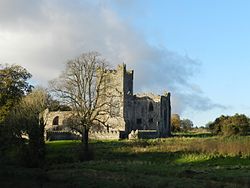Difference between revisions of "Tintern Abbey, County Wexford"
(Created page with "{{Infobox monastery |name=Tintern Abbey |irish=Mainistir Thinteirn |county=Wexford |picture=Southern face of Tintern Abbey, Co Wexford.JPG |picture caption=Tintern Abbey |os g...") |
(No difference)
|
Latest revision as of 19:02, 20 June 2024
| Tintern Abbey Irish: Mainistir Thinteirn | |
|
County Wexford | |
|---|---|
 Tintern Abbey | |
| Location | |
| Grid reference: | S794101 |
| Location: | 52°14’13"N, 6°50’17"W |
| Order: | Cistercians |
| History | |
| Established: | c.1200 |
| Founder: | William Marshal, 1st Earl of Pembroke |
| Disestablished: | 25 July 1539 |
| Information | |
| Condition: | Ruined |
Tintern Abbey was a Cistercian abbey located on the Hook Peninsula of County Wexford. It is today in ruins, with some partial restoration.
The Abbey was founded in c.1200 by William Marshal, Earl of Pembroke, as the result of a vow he had made when his boat was caught in a storm nearby.[1] While the specific date of foundation is unconfirmed in some sources, in a 1917 analysis for the Royal Irish Academy, church historian J. H. Bernard suggests a foundation date of 3 December 1200.[2]
Once established, the abbey was colonised by monks from the Cistercian abbey at Tintern in Monmouthshire, of which Marshal was also patron. To distinguish the two, the mother house in Wales was sometimes known as "Tintern Major" and the abbey in Ireland as "Tintern de Voto" (Tintern of the vow);[3][4]
After the Dissolution of the Monasteries the abbey and its grounds were granted firstly to Sir James Croft, and then in 1575 to Anthony Colclough of Staffordshire, a soldier of Henry VIII. His descendants became the Colclough Baronets. The final member of the Colclough family to reside at Tintern was Lucey Marie Biddulph Colclough and, after she left in 1959, the Irish state started conservation and consolidation works on the site.[5]
Between 1982 and 2007, the National Monuments service of the Office of Public Works undertook a number of excavation and heritage development efforts at the abbey,[6][3] including special conservation measures for local bat colonies.[7] Additional works were undertaken after a fire in the site's visitor centre in 2012, which damaged part of the 19th century outbuildings on the abbey's grounds.[8][3]
Gallery
Outside links
| ("Wikimedia Commons" has material about Tintern Abbey, County Wexford) |
References
- ↑ Tintern Abbey: Fáilte Ireland
- ↑ John Bernard (bishop) (March 1917). "Foundation of Tintern Abbey (Co. Wexford)". Proceedings of the Royal Irish Academy (Hodges, Figgis & Co. Ltd (Dublin)) XXXIII (17): 528. https://johnthecaptainryan.blogspot.com/search?q=tintern.
- ↑ 3.0 3.1 3.2 "Tintern Cistercian Abbey". Monastic Ireland. The Discovery Programme. http://www.monastic.ie/history/tintern-cistercian-abbey/. Retrieved 25 January 2018.
- ↑ the 'vow' in question being Marshal's vow to build the abbey should he survive the storm
- ↑ "Tintern Abbey". Wexford Web. Archived from the original on 25 May 2011. https://web.archive.org/web/20110525004854/http://www.wexfordweb.com/tintern.htm. Retrieved 5 May 2011.
- ↑ "Abbey loses one set of visitors and gets ready for another". Irish Times. 11 February 1998. https://www.irishtimes.com/news/abbey-loses-one-set-of-visitors-and-gets-ready-for-another-1.134180. Retrieved 25 January 2018.
- ↑ "Abbey permits special access for bats". Irish Times. 14 July 1999. https://www.irishtimes.com/news/abbey-permits-special-access-for-bats-1.206086. Retrieved 25 January 2018.
- ↑ "Fire at Tintern 'may have been arson'". Irish Independent. Independent News & Media. 24 July 2012. https://www.independent.ie/regionals/newrossstandard/news/fire-at-tintern-may-have-been-arson-27517839.html. Retrieved 25 January 2018.

